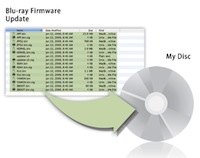

Blu-ray Firmware Updates: We Need a Better Solution
Mar 21, 2011 12:59 PM,
By Jason Bovberg
I recently visited my dad for a short vacation, and it was upon seeing the new state of his living room when I realized—quite happily—that Blu-ray has really attained widespread consumer acceptance. Here’s a senior citizen who has embraced the technology and actually understands its benefits: Along with his new Blu-ray player, he’d also purchased a brand-new 52in. Samsung LCD TV and had it installed beautifully on the most prominent wall like a work of art. And he also purchased a new Denon 7.1-channel surround sound AV receiver and full Klipsch audio setup. In short, he went whole-hog and really decked out that living room.
But one thing he couldn’t wrap his head around—and which, really, wasn’t explained to him sufficiently—was that he would probably need to eventually update his new Blu-ray player with firmware updates in order to keep it in working order.
“Um, what?” he asked, confused.
“Well, yeah,” I said, “Blu-ray is a continually evolving technology that requires frequent tweaking and updating to bring it to its full potential.”
“You’re kidding.”
I went into techno-speak: “Most of it has to do with digital rights management, a technology that studios use to discourage piracy. The drawback is that it can make some discs unplayable until you update the player’s firmware. Other firmware updates are just for tweaking the player’s capabilities or fixing other software problems …”
He just stared at me, appalled. “So they’re making me work on my own player to fix THEIR broken product?”
My dad sees the very notion of firmware updates as a flaw in the design.
I had my own opinions about DRM that I decided not to share with him—namely, that DRM probably does more harm than good by infuriating paying customers and not providing much of a roadblock to the real bad guys out there. My dad didn’t care about the realm of movie piracy; he just cared about having a piece of modern technology that worked right every time.
And when he recently received a copy of Knight and Day from Netflix that wouldn’t play, he was nearly apoplectic—particularly after sending the first copy back for a second copy that didn’t work either. And neither did the third copy work. It was at that point that I arrived for my visit, so I hastily performed a Google search, located the necessary firmware update, burned it to disc (he lacked an Internet connected for his otherwise BD Live connected player), and effortlessly installed it. After doing so, the disc played just fine.
He watched all this goggle-eyed.
My dad believes that a piece of technology should come out of the box in a state of finalized perfection. There should be no need to “fix” that product after it is purchased—indeed, even after it has been boxed up and shipped to stores. To him, that simply indicates a faulty product.
Does he have a point? His perspective is that the companies developing our technology today seem increasingly unable to finish the job. Consider the tech devices in your home—do they work more reliably than their predecessors 10 or 20 years ago? We’re in an era when our TVs are more fragile, our cable boxes freeze and drop content, our game systems blast us with red rings of death, and our video players choke on movies and require “fixing” via firmware updates. Even DVDs played more reliably than our technically superior Blu-ray discs.
That would neatly sum up one of his rants, and part of me agrees with him. I’m a Luddite in certain ways. (Full confession: I don’t even own a cell phone.) We’re in the midst of a technological revolution, and yet I sometimes feel that we’re just barely keeping up. We want the “next new thing” so quickly now that we’re not allowing sufficient time for tech evolution. Competition and consumer demand are so insanely hot and bothered that new editions of products slam into stores before they’re actually ready for prime time. That’s more my dad’s way of thinking than mine, but I share it to a certain degree.
Blu-ray Firmware Updates: We Need a Better Solution
Mar 21, 2011 12:59 PM,
By Jason Bovberg
But there’s another point of view—one that captures my perspective a little better—and that’s that the concept of continuous technology updating nicely reflects our 21st century always-connected lifestyle. I think the fact that we can connect our devices to the Internet and have the ability to constantly improve those devices (I use the term “improve” in an optimistic, theoretical way) is quite excellent. It speaks to a new era of technology that lets our systems evolve during their lifetimes. Just as we constantly update our computers with product revisions and security protections, we can now apply that kind of “ongoing improvement” mentality to our home entertainment.
But what of the delivery mechanism for these firmware updates? Because that’s really the main source of frustration for my father (and probably many like him). Let’s face it: The vast majority of the increasingly large Blu-ray audience hasn’t connected their players to the Internet, either through a wired Ethernet connection or wirelessly. It’s just not in the popular mindset to do so. Sure, most people understand that their players have the ability to connect, but they haven’t really grasped the reasons sufficiently to actually get beyond the inconvenience or cost of making it happen. Equally problematic is the notion of finding and downloading the firmware update from the vendor website, obtaining writable CDs, and burning it to disc.
“I shouldn’t have to do that!” my dad would say.
So, why not make it simple? I propose including the latest firmware updates on the latest Blu-ray discs themselves. After all, these are generally small files, and even including options from an array of manufacturers would fit within the vast storage space available on a Blu-ray disc. And if a little extra space is necessary, get rid of those annoying forced trailers and Blu-ray advertisements at the start of the disc! (“Yes, we already understand the benefits of Blu-ray! That’s why we bought this player and are playing THIS DISC!”)
With this solution in hand, my dad would simply insert the latest Blu-ray disc he gets from Netflix, and it would prompt him, “Do you wish to update your player to Samsung Firmware version X.XX?” and he would choose Yes or No. Simple as that.
It’s sure a heck of a lot better than including a card inside the Blu-ray case that simply says, “You may need to perform a firmware update to play this disc.” See, that just infuriates consumers like my dad. And to be honest, my proposed solution would be a lot easier on me, too.










